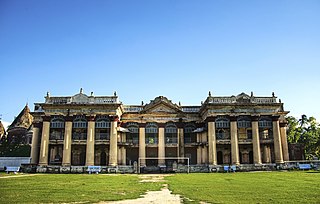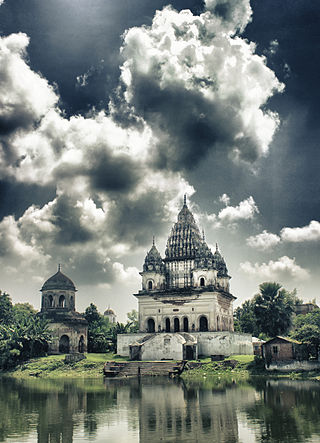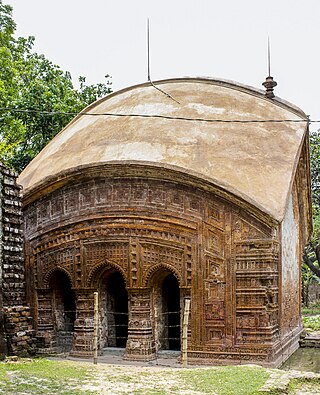Related Research Articles

Rajshahi District is a district in mid-western Bangladesh. It is a part of the Rajshahi Division. The metropolitan city of Rajshahi is in Rajshahi District.

The Architecture of Bengal, which comprises the modern country of Bangladesh and the Indian states of West Bengal, Tripura and Assam's Barak Valley, has a long and rich history, blending indigenous elements from the Indian subcontinent, with influences from different parts of the world. Bengali architecture includes ancient urban architecture, religious architecture, rural vernacular architecture, colonial townhouses and country houses and modern urban styles. The bungalow style is a notable architectural export of Bengal. The corner towers of Bengali religious buildings were replicated in medieval Southeast Asia. Bengali curved roofs, suitable for the very heavy rains, were adopted into a distinct local style of Indo-Islamic architecture, and used decoratively elsewhere in north India in Mughal architecture.

Puthia is an Upazila of Rajshahi District in the Division of Rajshahi, Bangladesh.

The Puthia Temple Complex consists of a cluster of notable old Hindu temples in Puthia Upazila, Rajshahi District, Bangladesh. Located 23 km to the east of Rajshahi city, it has the largest number of historic temples in Bangladesh. The temples were built by Hindu Zamindars Rajas of the Puthia Raj family who were noted philanthropists of Rajshahi. The temples have been built in terracotta in a variety of styles combining the typical Jor-bangla architecture with other influences. The Rajbari or Palace of the Raja of Puthia and the Dol Mancha are part of the complex. The temples are laid out around a lake with a sprawling lawn.

Architecture of Bangladesh is intertwined with the architecture of the Bengal region and the broader Indian subcontinent. The architecture of Bangladesh has a long history and is rooted in Bangladesh's culture, religion and history. It has evolved over centuries and assimilated influences from social, religious and exotic communities. The architecture of Bangladesh bears a remarkable impact on the lifestyle, tradition and cultural life of Bangladeshi people. Bangladesh has many architectural relics and monuments dating back thousands of years.

Natore Rajbari was a royal palace in Natore, Bangladesh. It was the residence and seat of the Rajshahi Raj family of zamindars. The famous queen Rani Bhabani lived here and after the death of her husband, expanded both the estate and the palace.

Zamindars of Natore were influential aristocratic Bengali Zamindars, who owned large estates in what is today Natore District in Bangladesh .

Puthia Rajbari is a palace in Puthia Upazilla, Rajshahi in Bangladesh, built in 1895, for Rani Hemanta Kumari Debi, it is an example of Indo-Saracenic Revival architecture. The palace is sited on the Rajshahi Natore highway 30 km from the east of the town and one km south from Rajshahi Natore highway. It is currently used by Lashkarpur Degree College but is in a poor state of repair.

The Pancha Ratna Govinda Temple in Puthia village, Rajshahi district in Bangladesh. The temple is a striking monument, which was built in the 19th century. It has the architectural feature of five ratnas or spires. It is located within the inner precincts of the Puthia Rajbari or palace.

Pancha Ratna Shiva Temple, also known as Bhubaneswar Shiva Mandir, is a Hindu temple of the Puthia Temple Complex in Puthia Upazila, Rajshahi Division, Bangladesh. It is the largest Shiva temple in Bangladesh. The shrine overlooks the Shiv Sagar to its left. The temple is well decorated in pancharatna architectural style and is located at the entrance of the Puthia Rajbari. Among the surviving Hindu temples, this shrine is said to be "an exceptional and more attractive for its architectural beauty" in Bangladesh.

Chauchala Chhota Govinda Mandir is a Hindu temple of the Puthia Temple Complex in Puthia Upazila, Rajshahi Division, Bangladesh. The temple is believed to date to the 1790s-1800s period.

Bara Ahnik Mandir is a Hindu temple of the Puthia Temple Complex in Puthia Upazila, Rajshahi Division, Bangladesh. It stands next to Chauchala Chhota Govinda Mandir and faces east. Architecturally it is exceptional for Bangladesh, the only other of known existence of this type being Rajaram Mandir in Faridpur District. It was built by the Rajas of Puthia.
Tarapur Mandir is a Hindu temple of the Puthia Temple Complex in Puthia Upazila, Rajshahi Division, Bangladesh. Its construction is dated to the 18th century. It is also known by other names as Rath Bagicha Tarapur and Hawakhana among the local residents.

Dol-Mandir, also known as Dol-Mandav is a Hindu temple of the Puthia Temple Complex in Puthia Upazila, Rajshahi Division, Bangladesh. It is located within the Puthia market area. An inscription dates the temple to 1778 built by Vubanendra Narayan, the Panch Ani Raja.
Chhota Shiva Mandir is a Hindu temple of the Puthia Temple Complex in Puthia Upazila, Rajshahi Division, Bangladesh. The temple, built in 1804, is credited to the Raja Anandanarayan of the Chauddapai.
Gopal Mandir also called as Dwarkadhish temple is the second largest temple of Ujjain after Mahakaleshwar and is dedicated to Lord Krishna, in Ujjain City, Ujjain Division, Madhya Pradesh, India. It was built by Bayaji bai Shinde, the wife of Maratha King Daulatrao Scindia in the 19th century in Maratha Style. It is located in the main market of Ujjain.

Chota Anhik Mandir is a Hindu temple of the Puthia Temple Complex in Puthia Upazila, Rajshahi Division, Bangladesh.

Bengal temple architecture is about temple styles developed and used in Bengal, particularly the chala, ratna and dalan temples.
References
- ↑ Alam, Mahmamuda, Puthia temple complex: Developing tourism through architecture (PDF), BRAC University, p. 27, archived from the original (PDF) on 22 October 2021, retrieved 11 May 2015
- ↑ "Puthia Rajbari". Do-Chala Chhota Ahnik Mandir. Rajshahi University Web Page. Archived from the original on 18 May 2015. Retrieved 12 May 2015.